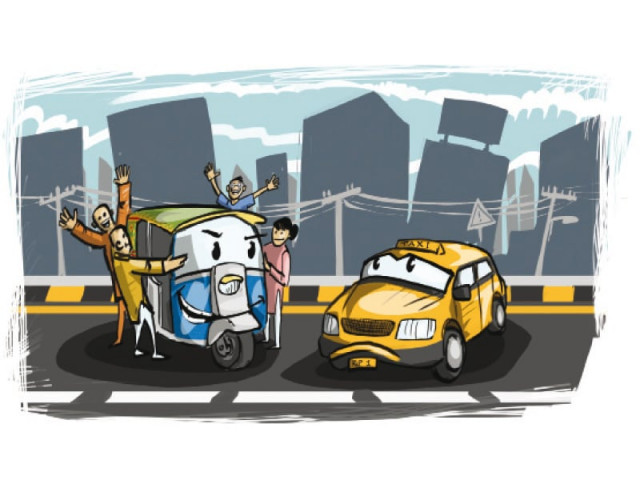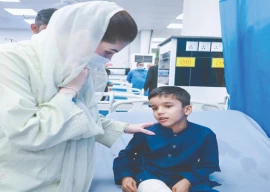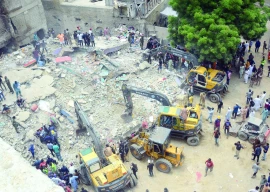
If you are a student, chances are that you will prefer a minibus, coach, or a Qingqi rickshaw over a 1970s black-and-yellow coloured Datsun or Toyota Corolla taxi.
It has been almost 19 years since the city got its last burst of new taxis under then Prime Minister Nawaz Sharif’s Yellow Cab scheme. According to Hafizul Haq Hasanzai, president of the Karachi Rickshaw, Taxi and Yellow Cab Owners Association (KRTYCOA), around 26,000 1970s Datsun taxis and 14,000 yellow cabs operate in the city, thus bringing the total count to 40,000. “There used to be more than 70,000 taxies and yellow cabs in Karachi. But some of them were sold for scrap, while others were torched whenever violence broke out. Most of the yellow cabs were taken to other cities,” says Hasanzai.
The city’s current stock of taxis comprises Suzuki and Hyundai vehicles, in addition to the old Datsuns and Corollas.
In comparison, according to a policy paper issued by the United Kingdom’s Office of Fair Trading in 2002, there were 19,200 taxis in London by 1998. Meanwhile, the New York Taxi and Limousine Commission regulates around 50,000 vehicles, including the traditional Yellow Cabs, as well as, other for-hire vehicles.
Hasanzai admits that one of the principle reasons for the decline in the number of taxis in Karachi is the growing number of CNG rickshaws and Qingqis, which can not only accommodate more people but are also economical. For example, a cab ride from Gulistan-e-Jauhar to Korangi can cost the passenger around Rs350. A CNG rickshaw driver is expected to charge around Rs200 for the same distance.

Jabbar Shah, 50, says that he has been in the public transport sector for the last 30 years. At one time, he remembers with relish, he would make as much as Rs1,200 a day by carrying passengers in his 1993 Hyundai yellow cab. “Now I make Rs500 on a good day. People prefer CNG rickshaws because they are affordable.” He also laments that the popularity of rickshaws, as well as the deteriorating law and order situation in Karachi, has spooked investors from bringing new taxis on the city’s roads.
Hasanzai says that another reason for the low number of taxis in the city is that their cost has gone up exponentially over the last couple of decades. A Datsun vehicle was available for Rs22,000 in 1976, claims Hasanzai. However, the company later stopped making the cars, leading transporters to import reconditioned vehicles until 1983.
“Then [Nawaz Sharif’s] scheme came around and people got cars on easy installments. But the cost of new vehicles has now crossed Rs1 million which is beyond the reach of many people,” says Hasanzai. The government’s refusal to compensate owners and drivers whose vehicles are torched by mobs also does not help.
Affordable for transporters and passengers alike
The price of a 4-stroke CNG rickshaw, says Hasanzai, hovers between Rs170,000 to 190,000. More than 70,000 of these are currently operating on Karachi’s roads, and more passengers prefer them over taxis because they charge less.
“Then the government threw Qingqi rickshaws into the fray, which destroyed the entire public transport system,” says Sahabzada Nisar Ahmed, general secretary of KRTYCOA. They are supposed to operate on service roads only, but they can be found on main roads all over the city, alleges Ahmed.

Almost 20,000 Qingqis in Karachi operate in areas like Gulistan-e-Jauhar, Gulshan-e-Iqbal, Nazimabad, Sohrab Goth, Landhi, Liaquatabad and New Town. Their fare ranges between Rs10 and Rs20, causing severe losses to minibus and coach operators in these areas. Ahmed blames the government for not taking public transport seriously.
Sindh Transport Deputy Secretary Ali Nawaz Panhwar, however, claims that the government is encouraging private companies to invest in public transport and to bring new vehicles on the metropolis’ streets. “The Karachi Public Transport Society helps private cab service providers and protects them from unnecessary interrogation by traffic police officials,” says Panhwar. Perhaps to rub salt on Jabbar Shah’s wounds, Panhwar added the government distributed 1,300 CNG rickshaws in the province.
Published in The Express Tribune, November 30th, 2012.


1724919650-0/Untitled-design-(5)1724919650-0-270x192.webp)














COMMENTS
Comments are moderated and generally will be posted if they are on-topic and not abusive.
For more information, please see our Comments FAQ